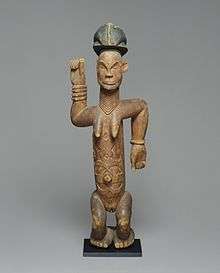Kongo cosmogram
The cosmogram was a core symbol of the Kongo culture. An ideographic religious symbol, the cosmogram was called dikenga dia Kongo or tendwa kia nza-n' Kongo in the KiKongo language.[1][2][3] Ethnohistorical sources and material culture demonstrate that the Kongo cosmogram existed as a long-standing symbolic tradition within the BaKongo culture before European contact in 1482, and that it continued in use in West Central Africa through the early twentieth century.[1] In its fullest embellishment, this symbol served as an emblematic representation of the Kongo people and summarized a broad array of ideas and metaphoric messages that comprised their sense of identity within the cosmos.[4]

Robert Farris Thompson describes it as thus: "Coded as a cross, a quartered circle or diamond, a seashell spiral, or a special cross with solar emblems at each ending - the sign of the four moments of the sun is the Kongo emblem of spiritual continuity and renaissance par excellence. In certain rites it is written on the earth, and a person stands upon it to take an oath, or to signify that he or she understands the meaning of life as a process shared with the dead below the river or the sea - the real sources of earthly power and prestige, in Kongo thinking... The intimation, by shorthand geometric statements, of mirrored worlds within the spiritual journey of the sun, is the source and illumination of some of the more important sculptural gestures and decorative signs pertaining to funerary monuments and objects designated for deposit on the surface of funerary tombs, or otherwise connected with funerary ceremonies and the end of life."[1]
References
- Thompson, Robert Farris; Cornet, Joseph (1981). The four moments of the sun : Kongo art in two worlds. Washington, D.C.: National Gallery of Art, Washington. ISBN 0-89468-003-X.
- MacGaffey, Wyatt; John M. Janzen (1974). An Anthology of Kongo Religion: Primary Texts From Lower Zaire (University of Kansas Publications In Anthropology. No. 5). University of Kansas. ASIN B0006CI6EO.
- Fu-Kiau, Kimbwandènde Kia Bunseki (2001). Tying the spiritual knot : African cosmology of the Bântu-Kôngo : principles of life & living (2nd ed.). Brooklyn, N.Y.: Athelia Henrietta Press. ISBN 1-890157-28-7.
- Fennell, Christopher. "Multivalent Symbols of an Enclosing Hand". African Diaspora Archaeology Network. Chris Fennell of the Department of African American Studies, Center for African Studies, and the Department of Anthropology at the University of Illinois. Retrieved 3 June 2013.